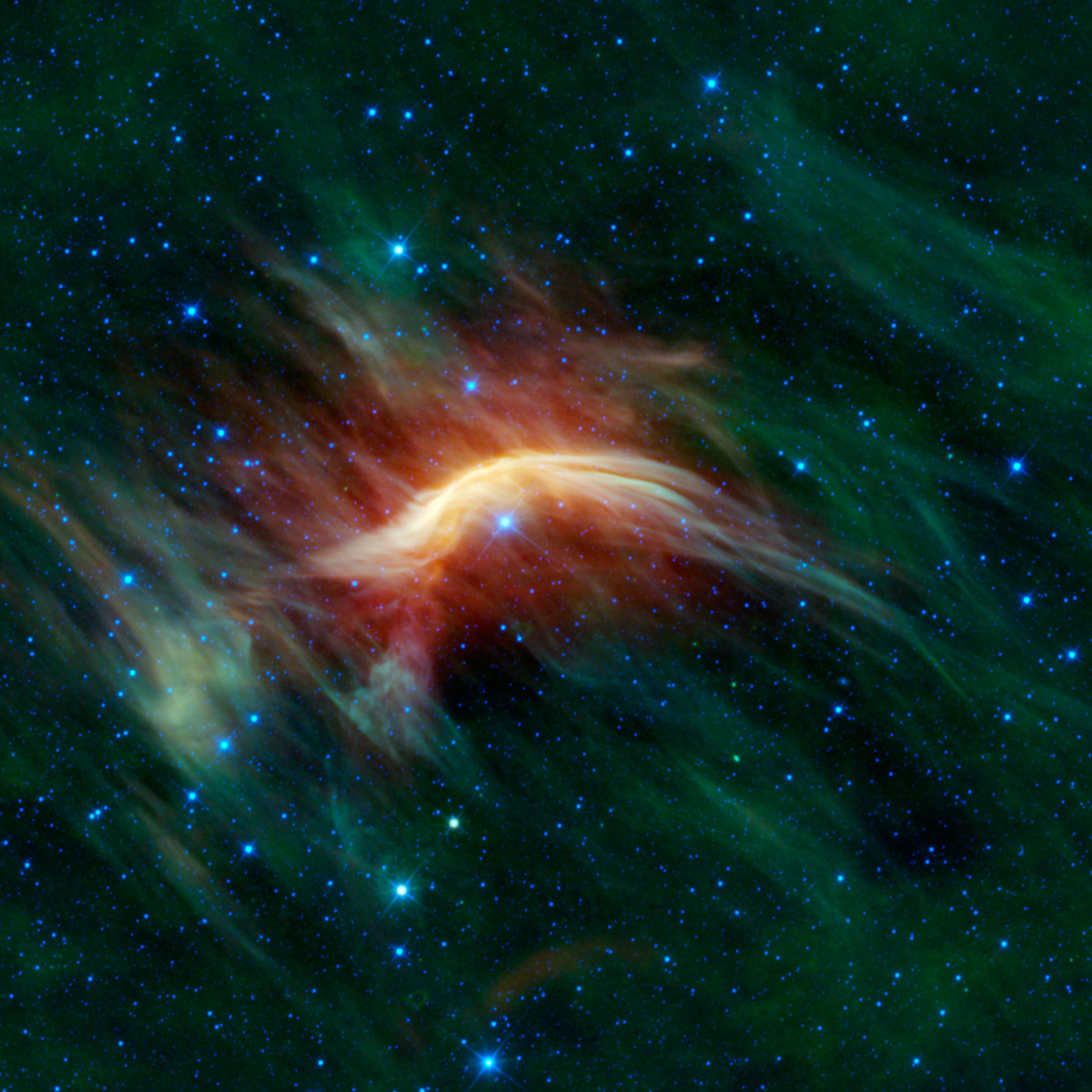
Lots of folks seem to be up in arms about the “new” sign in the zodiac, Ophiuchus, and the news that all the star signs are no longer in sync with the actual constellations. Of course, *most* of us already knew that news is centuries old, and that the zodiac has no effect whatsoever on our lives and it never has (most readers of Universe Today, anyway!) Now for some real news about Ophiuchus: NASA’s Wide-field Infrared Survey Explorer, or WISE has found a massive, runaway star, called Zeta Ophiuchi that is plowing through a cloud of space dust in Ophiuchus. The result is a brilliant bow shock, seen here as a yellow arc in this stunning new image.
Zeta Ophiuchi is a big mama, with a mass of about 20 times that of our sun. In this image, in which infrared light has been translated into visible colors we see with our eyes, the star appears as the blue dot inside the bow shock.
Zeta Ophiuchi once orbited around an even heftier star. But it was a fatal attraction. When that star exploded in a supernova, Zeta Ophiuchi shot away like a bullet. It’s traveling at a whopping 24 kilometers per second (54,000 miles per hour), and heading toward the upper left area of the picture.
As the star tears through space, its powerful winds push gas and dust out of its way and into what is called a bow shock. The material in the bow shock is so compressed that it glows with infrared light that WISE can see. The effect is similar to what happens when a boat speeds through water, pushing a wave in front of it.
This bow shock is completely hidden in visible light. Infrared images like this one from WISE are therefore important for shedding new light on the region.
And that’s the real news from Ophiuchus.
But if you want to know the “real” dates of astrological signs according to astronomers, (not astrologers) here they are (courtesy of Live Science, via Discovery Space — see those two links if you missed all the excitement about star signs changing…):
Capricorn: Jan. 20-Feb. 16.
Aquarius: Feb. 16-March 11.
Pisces: March 11-April 18.
Aries: April 18-May 13.
Taurus: May 13-June 21.
Gemini: June 21-July 20.
Cancer: July 20-Aug. 10.
Leo: Aug. 10-Sept. 16.
Virgo: Sept. 16-Oct. 30.
Libra: Oct. 30-Nov. 23.
Scorpio: Nov. 23-29.
Ophiuchus: Nov. 29-Dec. 17.
Sagittarius: Dec. 17-Jan. 20.
Source: JPL

About one year ago I was investigating the Bullet Pillars in Orion, and discovered some very interesting data. (here is one paper with data by: J.-K.Lee and M.G. Burton – An infrared proper motion study of the Orion bullets. Mon. Not. R. Astron. Soc. 315, 11-20 (2000) ) [sorry, I don’t have a link to it]
The apropos quotes are on pg. 18 – 19 in the Discussion section.
“No differential motion, however, between [Fe II] bullets and their H2 wakes is observed. While limits on such motion remain weak over a 4-year time-scale, this suggests that the bullets are not separating from their wakes. Together with the lack of any morphological changes, the wakes also cannot be stretching. In other words, each bullet and wake appear to be moving together.” [pg. 18]
“The projected distances of bullets from the IRc2 complex are plotted against their proper motion speeds in Fig. 8. Excluding No. 20 which was problematic in its measurement, the plot suggest that the more distant bullets, in general, are moving faster.” [pg. 19]
My question is: What would cause the further bullets to achieve a greater velocity than the closer-in bullets, to their common origin source location, over time ?
My answer is that they are in a continuing ‘field’ that is causing their acceleration, and they were not the subject of some ‘explosive’ event at their common point of origin.
That said, in regards to Zeta Ophiuchus, I would suggest a longer term study of this structure to see if the ‘bow shock’ is moving ‘with’ Zeta O, or is it further deforming around it; and if the ‘braids’ in its ending tendrils, on the right-hand side, change their morphology over time as well.
[another great article by Nancy Atkinson !]
A sensible reply;
The article is “An infrared proper motion study of the Orion bullets” through the link;
http://adsabs.harvard.edu/abs/2000MNRAS.315…11L
Cheers
That’s a beautiful picture. Thanks for the article. But this phrase is a bit meaningless to me:
“[The star]’s traveling at a whopping 24 kilometers per second”
How does this compare with the speeds of other stars – the average star, our sun, the fastest star detected, etc etc.